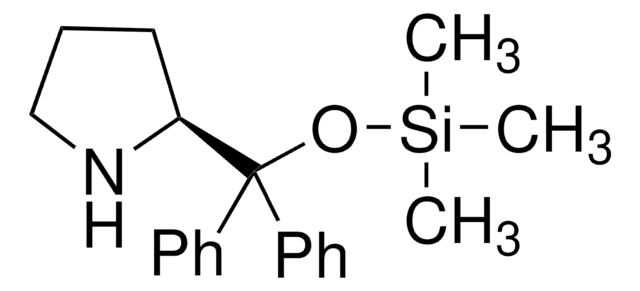679186
Acetonitrile solution
suitable for HPLC, contains 5 % (v/v) water, 0.1 % (v/v) formic acid, 0.05 % (w/v) ammonium formate
Synonim(y):
ACN, Cyanomethane, Ethyl nitrile, Methyl cyanide
About This Item
Polecane produkty
product name
Acetonitrile solution, contains 0.05 % (w/v) ammonium formate, 5 % (v/v) water, 0.1 % (v/v) formic acid, suitable for HPLC
gęstość pary
1.41 (vs air)
Poziom jakości
ciśnienie pary
72.8 mmHg
Postać
liquid
zawiera
0.05 % (w/v) ammonium formate
0.1 % (v/v) formic acid
5 % (v/v) water
granice wybuchowości
8 % (lit.)
metody
HPLC: suitable
tw
81-82 °C (lit.)
mp
-48 °C (lit.)
gęstość
0.782 g/mL at 25 °C
0.807 g/mL at 25 °C
format
mixture
ciąg SMILES
CC#N
InChI
1S/C2H3N/c1-2-3/h1H3
Klucz InChI
WEVYAHXRMPXWCK-UHFFFAOYSA-N
Szukasz podobnych produktów? Odwiedź Przewodnik dotyczący porównywania produktów
Powiązane kategorie
Opis ogólny
Zastosowanie
- Detection of Amino Acids via Chemiluminescence: Acetonitrile is employed in the detection of α-amino acids using peroxyoxalate chemiluminescence. A study demonstrated the use of a mixed solution of water, acetonitrile, and ethyl acetate for detecting amino acids, highlighting its efficacy in analytical applications. This method enhances the sensitivity and accuracy of amino acid detection, making it crucial for biochemical and clinical analyses (Kan et al., American Journal of Analytical Chemistry, 2020).
- Redox Properties of N-Hydroxyimides: Acetonitrile mixed with sulfuric acid is used to study the redox properties of N-hydroxyimides, acting as a hydrogen atom transfer (HAT) mediator for alcohol oxidation. This application is significant in understanding the electrochemical behavior of organic compounds and developing new catalytic processes for oxidation reactions (Kishioka, Journal of Electroanalytical Chemistry, 2023).
- Electrode Reactions in Catalytic Mediation: Acetonitrile solution is used in investigating the electrode reactions of N-hydroxyphthalimide in sulfuric acid. This study focuses on its role as a catalytic mediator for alcohol oxidation, providing insights into the electrochemical mechanisms involved. The findings contribute to the development of efficient catalytic systems for organic transformations (Kishioka, Journal of Electroanalytical Chemistry, 2022).
- Excitation of Europium Complexes: Acetonitrile solution is utilized in the interaction of Eu(FOD)3 with xenon difluoride to study ligand-assisted excitation of Eu(III). This research explores the photophysical properties of europium complexes, which are essential for developing luminescent materials for various applications, including lighting and display technologies (Masyagutova et al., Journal of Fluorine Chemistry, 2024).
Uwaga dotycząca przygotowania
Hasło ostrzegawcze
Danger
Zwroty wskazujące rodzaj zagrożenia
Zwroty wskazujące środki ostrożności
Klasyfikacja zagrożeń
Acute Tox. 4 Dermal - Acute Tox. 4 Inhalation - Acute Tox. 4 Oral - Eye Irrit. 2 - Flam. Liq. 2
Kod klasy składowania
3 - Flammable liquids
Klasa zagrożenia wodnego (WGK)
WGK 3
Temperatura zapłonu (°F)
36.0 °F - closed cup
Temperatura zapłonu (°C)
2.22 °C - closed cup
Środki ochrony indywidualnej
Eyeshields, Faceshields, Gloves, type ABEK (EN14387) respirator filter
Choose from one of the most recent versions:
Masz już ten produkt?
Dokumenty związane z niedawno zakupionymi produktami zostały zamieszczone w Bibliotece dokumentów.
Nasz zespół naukowców ma doświadczenie we wszystkich obszarach badań, w tym w naukach przyrodniczych, materiałoznawstwie, syntezie chemicznej, chromatografii, analityce i wielu innych dziedzinach.
Skontaktuj się z zespołem ds. pomocy technicznej



![(S)-α,α-Bis[3,5-bis(trifluoromethyl)phenyl]-2-pyrrolidinemethanol trimethylsilyl ether 97%](/deepweb/assets/sigmaaldrich/product/structures/396/398/09a397b1-b5f5-420f-98da-adf9017cef56/640/09a397b1-b5f5-420f-98da-adf9017cef56.png)


